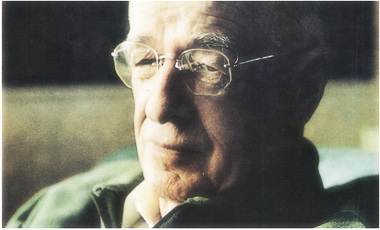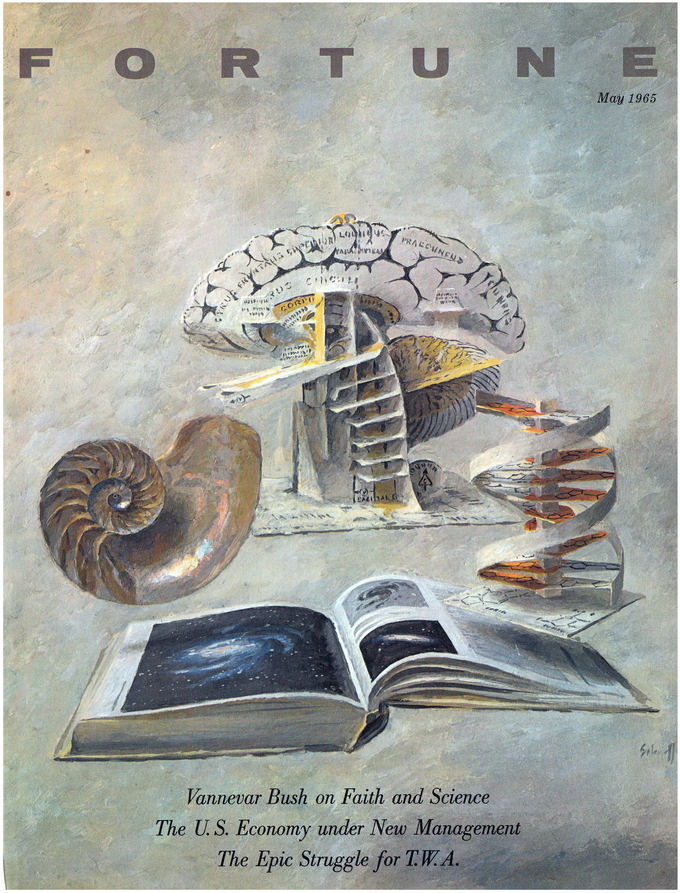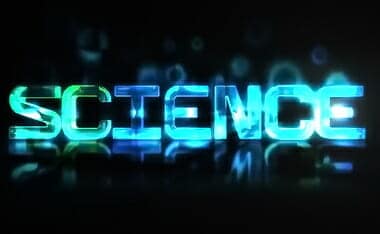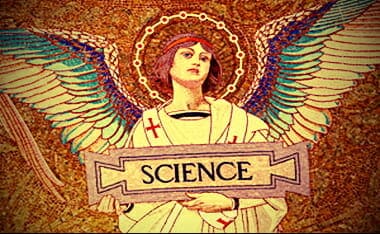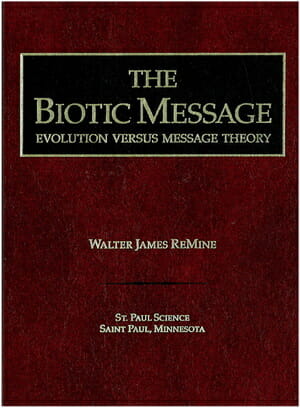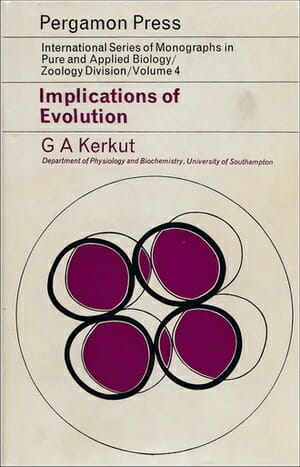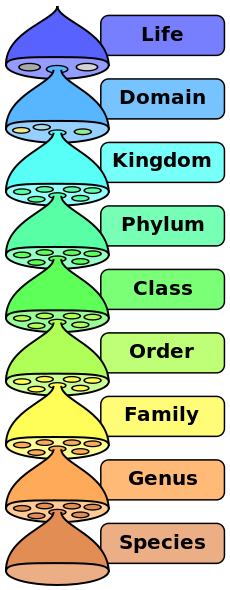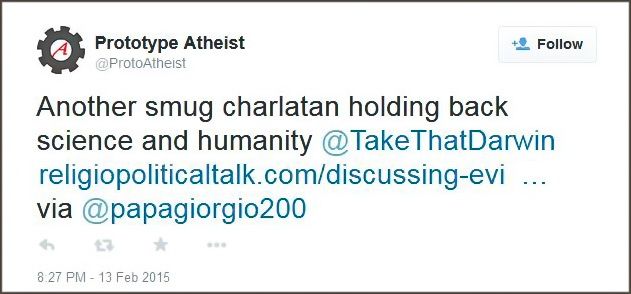The entire article is reproduced below (page 117 was a full page photo of Dr. Bush):
Vannevar Bush, Science Pauses (Fortune Magazine, 1965), 116-119, 167-168, 172.
“There is a misconception… that scientists can establish a complete set of facts and relations about the universe… and that on this firm basis men can securely establish their personal philosophy, their personal religion, free from doubt or error.”
Here is a PDF of the article.
Science Pauses
By Vannevar Bush
[p.116>]People have always held queer ideas about scientists. Once they were regarded as long-haired idealists, likely to wear one black shoe and one tan. Some days they ate two lunches, and some days none, for their thoughts were not on mundane things.
Then came the A-bomb. Now scientists are regarded as supermen. They can do anything, given enough money. If America wants to put a man on the moon, which is really a tough engineering job, just gather enough thousands of scientists, pour in the money, and the man will get there. He may even get back.
In such moonbeams there is a misconception about scientists and the nature of science. But carried within this there is still another misconception, much more serious. This is the misconception that scientists can establish a complete set of facts and relations about the universe, all neatly proved, and that on this firm basis men can securely establish their personal philosophy, their personal religion, free from doubt or error.
Much is spoken today about the power of science, and rightly. It is awesome. But little is said about the inherent limitations of science, and both sides of the coin need equal scrutiny. The impact of science on men’s minds has been long in the making, but the age of Galileo gives us one place to start.
Galileo did not, as the Encyclopedia Britannica for so many years asserted, drop heavy and light weights from a tower and watch them fall together. (They would not have fallen together if he had.) He did roll balls down inclined grooves and time their progress. In so doing he developed the first laws of nature, if we wish to call them that, based on observation and calculation. He was not alone, but he was preeminent in his time.
Galileo caused quite a bit of turmoil in intellectual circles. Some of his colleagues refused to look through the telescope he had fashioned. Some looked and refused to believe what they saw—moons swinging around Jupiter, for example. The Church frowned upon him, but did not burn him. He personified a new spirit, and carried with him a new intellectual freedom rising throughout Europe. Here was a new liberty of thought to contend with—and to suppress if possible.
No doubt many, or most, of those who tried to prevent this awakening were moved by a desire to perpetuate the privileges of an organized priesthood. But there were honest men as well, and their point of view was most understandable, even if shortsighted and doomed.
For centuries men had been indoctrinated in a complex system of myths, built on what had originally been a simple religion but embroidered through the years by tradition and responding to the human tendency to elaborate and ornament. Upon this was erected a rigid code of conduct, enforced by authority based upon asserted superior knowledge and upon the fear of Hell. The only science admitted was the science of Aristotle—including its absurdities. The only reasoning permitted about man or nature followed the strict logic of Aristotle—including its fallacies. The scholastics argued learnedly about angels. But they did not open an egg and observe the growth of an embryo.
If man now began to learn about nature himself, if he were moved to cut even partway loose from authority and throw out some of the old myths, the code of ethics would go overboard also, whereupon the mass of men would revert to savagery. This at any rate was the conviction held by many devoted persons. It was indeed a courageous adventure that began when men decided to try to understand nature on their own, and embark on the hazardous endeavor of building a philosophy of life upon observed facts. We have not yet seen the end of this experiment. It was no wonder that intelligent men, with sincere and worthy motives, hesitated to take the plunge.
Another jolt to entrenched tradition came when Newton and Leibnitz invented the calculus, and when such geniuses as d’Alembert, Euler, Lagrange, and Gauss built an amazing structure of dynamics and optics. A sparkling assemblage of equations, developed with marvelous ingenuity, could predict the movements of the planets with precision, or the precession of a gyroscope, or the path of light through an assemblage of lenses. Nowhere in the whole history of human thought has there been a finer example [p.118>]of the power of the intellect than in this seventeenth- and eighteenth-century burst.
This burst of analysis is important to ponder today because it led, widely, to a philosophy of materialism, and an especially unattractive form of it. Soon man would be able to understand all of nature, this philosophy ran. Everything would be controlled by a neat set of equations. Merely by observing the present state of things, one could predict all the future. All the history of the universe, all of man’s part in it, was, so it seemed, controlled by causal, mechanistic laws. Man was merely an automaton. His fancied choice of acts was an illusion; he merely carried out what was inevitable in the light of his nature and nurture. Pride of intellect never went further.
The extremes of materialism that flowed from these beginnings did not touch the mass of men. But later there came an upheaval that wrenched even the common man loose from his moorings. Darwin did not originate the theory of evolution, but his meticulous observation and exposition rendered it highly plausible. Herbert Spencer drew from it a great sweep of disquieting speculation. And the man in the street was suddenly confronted with the assertion that he was descended from an ape.
Worse was to come; it soon appeared that princes and people alike were even descended from a bacterium. Mythology came apart, and the question of the spontaneous origin of life was fiercely debated. If all living things had descended from some minute organism in a primeval soupy sea, did that organism itself appear by the chance joining of chemical constituents in that complex environment? Much of the reasoning and the experiment to try to prove or disprove the thesis of spontaneous generation was absurd. Men sealed up gooey liquids in glass tubes, heated them to destroy all life, and then argued that spontaneous generation was impossible because no new life appeared. But there was no accepted definition of “life.”
How does a spider know how to spin?
Today we are calmer, at least on that front, and it is generally accepted that life began with the appearance of the first self-reproducing molecule. This is merely a chemical capable of assembling, from chemical fragments about it, an exact duplicate of itself. One can grasp what would happen when such a molecule appeared in a warm, complex sea, full of all sorts of simple nonliving chemical structures, existing there by virtue of chemical processes and photochemical effects. These structures would have included such things as amino acids and nucleotides. (In the laboratory it has been shown that such things show up when light shines on a chemical soup, chosen to be like the primeval seas as we envisage them.) A single molecule, able to build a twin from such a mess, would proliferate prodigiously until it had used up all the available primary material with which it would combine. It would not be interfered with by predators since, for a time, it would be all alone. But the process would not stop there. By chance, other replicating molecules would appear. Some of these would proliferate by seizing upon material already combined; thereupon the great process of evolution would be on its way. After millennia cells with all their internal intricacy would appear, then organisms made up of cells in combination, then fish and plants and mammals, and finally man.
This account is persuasive because so much of life, as we observe it today, depends upon replicatory molecules. All of heredity, as we now depict it, depends on the genes, which are self-duplicating nucleic acids. These pass the characteristics of an individual from one generation to the next. They control the development of an organism, from sperm and egg to adult, by molding messenger chemicals, which in turn mold the proteins: the hormones, enzymes, and the structural materials that constitute the body ; those chemicals form and control your body and mine. The code by which the gene signals and controls is just now being deciphered in hundreds of laboratories. There is some question whether all this is sufficient to explain, for example, the linkages in the brain of a spider by which it knows how to spin a web without being taught, so we may be taking only the first step on a very long road. But there is no doubt that the molding of one molecule by another lies at the basis of the wealth of life we see about us.
Man has not yet succeeded in creating life as here defined, but there is little doubt that he soon will. Some very simple short-chain nucleic acid, synthesized from inert matter and placed in a chemical soup, will suddenly assemble accurate images of itself and the job will be done.
We seem, thus, to have arrived at a concept of how the physical universe about us—all the life that inhabits the speck we occupy in this universe—has evolved over the eons by simple material processes, the sort of processes we examine experimentally, which we describe by equations, and call the “laws of nature.”
Except for one thing! Man is conscious of his existence. Man also possesses, so most of us believe, what he calls his free will. Did consciousness and free will too arise merely out of “natural” processes? The question is central to the contention between those who see nothing beyond a new materialism and those who see—Something.
The enthusiasm, the exuberance, that properly accompanies the great achievements of science, the thrill of at last beginning to understand nature and the universe about us, in all their awesome magnificence, continues to lead many men all over the world, especially young men, on to [p.119>]this new materialism. In taking what they imagine to be their final steps, they conceive that they are merely following the dictates of science and carrying them to their inevitable and logical conclusion. In Russia, of course, materialism is the state religion. But the new materialism is by no means confined to those who further the Communistic organization of society. The philosophy of existentialism, with its powerful appeal to young men, takes many forms, but in every form there is a concern for what the existentialist believes to be science, which leads, more often than not, to a rigid atheism. Under whatever name or state they go, there is cause for much concern over those who follow science blindly, or relapse into a hopeless pessimism. It is earlier than they think.
Immortality in a machine
A relatively new development, and a potent one, gives support to the chain of ideas we need, today, to examine.
Long ago man built machines to supplement or replace his muscles or those of his beasts. He also built devices to supplement and extend his vision, so that he can now see the very small: the virus that preys on his flesh, and the very distant : the galaxy a billion light-years away. Instruments also extend his voice, so that he can speak across a continent, or to a satellite, which repeats his voice across an ocean. No longer content with the form of the materials he finds on the earth, he produces new metals and new chemicals. Dissatisfied with the sources of energy in fossil fuels, he taps the internal energy of the atom, and may soon find nearly inexhaustible resources in the sea. Beyond this he creates devices that control and guide his machines, so that they perform in concert to produce the things he needs or desires: automation with all its current problems and its future promise. Still further, he is learning to understand his own physical self, to make new chemical entities to cure his ills soon in similar manner he will conquer the grosser malfunctioning of his brain. All this creates modern civilization, with its comfort and its health, limited as yet to the few, but capable of encompassing all mankind if the race acts with wisdom and uses its new powers for the benefit of man’s true interests.
Now man takes a new step. He builds machines to do his thinking for him. These are still in their infancy, but their significance is great. It is one thing to supplement muscles and senses. It is a far more profound thing to supplement intellectual power. We are now in the early stages of doing just this, and in its success, if it is to succeed, we shall have a revolution that can make the industrial revolution, so called, seem a mere episode in mankind’s onward march.
Even the machines that have been built and used thus far do interesting things. They do in a minute a computation that would take an unaided man a year. They conduct the accounting of vast businesses. They search through their vast memories in a flash to produce a desired item. They translate languages, badly, and write poetry, badly. They will do better when they have been taught better. They compose music, still not interesting, but they will someday compose well. They refine the design of a bridge for an engineer, and take over the labor of drawing his concepts. They have not yet solved the problem of our libraries, about to be swamped by the deluge of printed matter, but someday they will.
But no machine has yet appeared that operates as the brain does. The brain does not operate by reducing everything to indices and computation. It follows trails of association, flying almost instantly from item to item, bringing into consciousness only the significant. Its associative trails bifurcate and cross, are erased by disuse and emphasized by success. Ultimately we shall produce a machine that can do all this better. Its memory will be far greater and the items will not fade. It will progress along trails at lightning speed. The machine will learn from its own experience, refine its own trails, explore in unknown territory to establish trails there. All this it will do under the orders of its master, and as his slave.
This personal machine has not yet appeared, and waits for progress on the machine of trails. When it does we shall encounter a new form of inheritance. A new form of immortality will arrive, not merely of genes, but of the intimate thought processes. The son will inherit from his father the trails his father followed as his thoughts matured, with the father’s comments and criticisms along the way. The son will select those that are fruitful, exchange with his colleagues, and further refine for the next generation. The fields he covers will encompass all he learns, all he creates and adopts; for the compass of his memory will be that of entire libraries. No longer, when he is old, will he forget.
When Mercury was found to wobble
Thus our speculations lead us: if scientists can settle the ancient question of the spontaneous generation of life by repeating the process in their laboratories, will not scientists also settle the next question by building machines that are conscious and that exhibit free will?
We can hardly approach this tremendous possibility directly. Rather let us consider how science operates, and hence what are its limitations.
Science never proves anything, in an absolute sense. It works by processes of induction, and of deduction. Let us take them in order. Science accumulates data, by observation and measurement. Today its observations are likely to be in the form of the positions of needles on dials, or the optical density of photographic film, or the count of particles arriving in a chamber, for most of the things observed are not accessible to the unaided senses. The scientist attempts to select phenomena in which only the variables to be studied are present, with extraneous influences excluded. From an assemblage of such data he constructs a hypothesis, a formula that expresses the relationships he finds. With this he predicts, and then measures to determine whether [p.167>]his prediction is valid. If there is general confirmation, and no facts appear in contradiction, he, and scientists generally, accept the hypothesis and proceed on their way. But at any time thereafter a single confirmed measurement found to be in flat contradiction with the hypothesis destroys it completely. The attempt is then made to refine the theory and remove the contradiction.
This has happened hundreds of times in the history of science. A good example lies in celestial mechanics. The observations of the planets by Tycho Brahe enabled Kepler to calculate that they moved about the sun in ellipses, and to formulate rules of their motions. Newton, with his treatment of gravitation, verified all this, and showed that the whole procedure could be calculated if one merely assumed that bodies attracted each other with forces proportional to their masses and inversely proportional to the square of the distances of their separation. He also assumed that geometry on the earth, the Euclidean geometry that harassed us in school, holds also in the wide spaces of the universe. The hypothesis, the theory if you will, held up under tests of prediction. Using nothing else, an eclipse could be predicted, the region of the earth where it would be seen, and the time of its advent at a particular spot. In fact, it held up marvelously; the prediction could be made to a second. Yet today it is regarded as merely an approximation, good enough for many purposes but by no means refined enough to apply generally.
What had happened? First, the planet Mercury was found, if one measured closely enough, to wobble in its flight—i.e., not to follow exactly the orbit that theory predicted. Second, the application of Euclidean geometry for the vast universe was shown to be only one assumption among three possible ones. When Einstein produced his general relativity theory, he cured the gross imperfections that had escaped the notice of Kepler and Newton—and the old theory became simply a special case adequate for most local needs. Few believe Einstein’s formulation is the last word, although no one has yet done better. But as for Newton’s assumption that Euclid’s geometry held throughout all his range of thought, this involves deductive reasoning, and deduction is more subtle.
More than one geometry
Deduction uses the rules of logic to proceed from a set of assumptions to their consequences. But we have troubles here. Logic itself is by no means a perfect tool and, even if it were, it could do no more than transfer the question of the validity of a deduced relationship to the question of the validity of the premises on which it is based. And these premises are merely statements that are assumed to be valid for the purposes of the argument: simple statements, so simple that they cannot be expressed in terms of statements which are more simple.
This is well illustrated by the history of geometry. Various Greeks, with admirable diligence and insight, developed logical reasoning about matters of geometry. Euclid compiled these thoughts into a form that lasted for two thousand years. He based his reasoning on a set of axioms, assumed to be self-evident, needing no proof or even examination. One of these was the so-called parallel postulate, the statement that if two perpendiculars are erected to a given line they will remain equidistant no matter how far extended. To the scholars of centuries ago this seemed fair enough. On the basis of these axioms it was proved, for one result, that the sum of the angles of a triangle is two right angles.
In the great age of analysis this parallel postulate was questioned by Gauss, Bolyai, Lobachevski. Gauss was so moved by what he found, perhaps appalled by what his colleagues might say, that he did not publish. The others did. In fact, they worked out whole systems of geometry, non-Euclidean geometry, based on the other possibilities. One is that if the perpendiculars are extended, perhaps out to the most distant regions of the universe, they will diverge. The other is that they will finally intersect. We cannot, at least today, settle by measurement which assumption is more probable. And we have no instinctive reason for believing in any of the three premises. Triangles made of straight lines extending out among the stars need no longer have as the sum of their angles two right angles. In fact, on one assumption we can conceive of a triangle with all of its three sides parallel, or asymptotic, in pairs, a triangle nevertheless of a specific area. On the other assumption, if we enlarge a triangle indefinitely it will approach the form of a circle, although its sides will still be straight lines. Space may be curved, an idea that it is hard to visualize with our limited three-dimensional outlook. The universe may be closed, but unlimited; there may be a longest line. We have no evidence that three dimensions are all that exist. Perhaps we observe merely a three-dimensional cross section of a four-dimensional universe.
The whole long process of deduction that built Euclidean geometry revealed fascinating relations; useful ones also, which enabled man to sail the wide seas, or to build telescopes of great power. But it proved none of these relationships; it merely transferred the question of their validity to that of the axioms upon which everything rested. And one of these axioms was shown to be merely one of three equally reasonable assumptions.
Stepping outside the system
Even prevailing logic itself came under closer scrutiny. Aristotle was found not to be as infallible as he had been considered for over a thousand years. Russell, and others, labored to remove the paradoxes and to straighten out the semantics. The subject became even more difficult when GOdel showed that no closed system could be proved to be free of contradictions without stepping outside the system.
Fortunately, a scientific endeavor does not have to be perfect in order to yield results. The magnificent structure of dynamics was based on a differential calculus that was, logically, full of holes. Mathematics, on a much firmer basis today, starts with simple assumptions, and produces unexpected and beautiful conclusions. Theorems that glitter, often quite useless when they appear and treasured for their aesthetic appeal, sometimes later become of direct utility. In exploring the nucleus of the atom today, with all its galaxy of particles, and its wholly mysterious relations, mathematics is used that was originally the prized possession of mathematics alone.
Science’s use of logic becomes more and more demanding: the symbolic logic of Russell and Whitehead has been one answer to this demand. Logic can proceed only when the entities with which it is concerned are strictly defined. Science can proceed only when it can observe with precision, and when it can measure. Mathematics becomes useful only when the quantities it manipulates have precise meaning. Many, most, of the classic philosophers sinned badly in this regard. They dreamed dreams, which was well, and constructed systems that were often fascinating. But then they dressed these up with logical arguments based on elements that they did not define, or even on elements that were undefinable. And [p.168>]they often announced their systems with dogmatism and an assumed superiority. Philosophy has come far since those days. It has had to.
Science, too, has come a long way, in delineating the probable nature of the universe that surrounds us, of the physical world in which we live, of our own structure, our physical and chemical nature. It even enters into the mechanism by which the brain itself operates. Then it comes to the questions of consciousness and free will and there it stops. No longer can science prove, or even bear evidence. Those who base their personal philosophies or their religion upon science are left, beyond that point, without support. They end where they began, except that the framework, the background, against which they ponder is far more elaborate, far more probable, than was the evidence when an ancient shepherd guided his flock toward the setting sun, and wondered why he was there, and where he was going.
Science proves nothing absolutely. On the most vital questions, it does not even produce evidence.
But is all the labor of science vain to the thinker, the seeker after a sure harbor, amid the mystery, evil, cruelty, majesty, that surrounds us? By no means. Science here does two things. It renders us humble. And it paints a universe in which the mysteries become highlighted, in which constraints on imagination and speculation have been removed, and which becomes ever more awe-inspiring as we gaze.
A belief larger than a fact
The first men who pondered did so on a small earth, which did not extend far beyond the horizon, for which the stars were mere lamps in the skies. Now, we are no longer at the center; there is no center. We look at congeries of stars by light that left them before the earth had cooled. Among the myriads of stars we postulate myriads of planets with conditions as favorable to life as is out earth. We puzzle as to whether the universe is bounded or extends forever; whether, indeed, it may be only one universe among many. We speculate as to whether our universe began in a vast explosion, whether it pulsates between utter compression and wide diffusion, whether it is self-renewing and thus goes on unchanged forever. And we are humble.
But science teaches more than this. It continually reminds us that we are still ignorant and there is much to learn. Time and space are interconnected in strange ways; there is no absolute simultaneity. Within the atom occur phenomena concerning which visualization is futile, to which common sense, the guidance from our everyday experience, has no application, which yield to studies by equations that have no meaning except that they work. Mass and energy transform one into each other. Gravitation, the solid rock on which Newton built, may be merely a property of the geometry of the cosmos. Life, as its details unfold before us, becomes ever more intricate, emphasizing more and more our wonder that its marvelous functioning could have been produced by chance and time. The human mind, merely in its chemical and physical aspects, takes on new inspiring attributes.
And what is the conclusion? He who follows science blindly, and who follows it alone, comes to a barrier beyond which he cannot see. He who would tell us with the authority of scholarship a complete story of why we exist, of our mission here, has a duty to speak convincingly in a world where men increasingly think for themselves. Exhortation needs to be revised, not to weaken its power but to increase it, for men who are no longer in the third century. As this occurs, and [p.172>]on the essential and central core of faith, science will of necessity be silent.
But its silence will be the silence of humility, not the silence of disdain. A belief may be larger than a fact. A faith that is over defined is the very faith most likely to prove inadequate to the great moments of life. The late Mr. Justice Holmes said, “the faith is true and adorable which leads a soldier to throw away his life in obedience to a blindly accepted duty, in a cause he little understands, in a plan of campaign of which he has no notion, under tactics of which he does not see the use.” Young men, who will formulate the deep thought of the next generation, should lean on science, for it can teach much and it can inspire. But they should not lean where it does not apply.
Modern philosophy divides, roughly, into two parts. One pores through the ancient record and attempts to recover from it thought that is worth preserving and to present this in modern dress. The other labors to refine our logical processes and our language, that we may reason more assuredly. This is not all that philosophy can do. It can return to its mission in its day of glory. It can dream and it can guide the dreams of men. To do so it will need to present its visions humbly, and in the concepts of the universe that science offers. There are a few who labor to do just this. Their task is difficult, for the universe that science presents as probable is continuously altering, and depends for its grasp upon mathematics that requires deep study for many years. Nevertheless, the opportunity is there to present wide-sweeping thought that will sway the minds of men.
And the theologian. He can accept the aid of science, which draws for him a wide universe in all its majesty, with life in all its awe-inspiring complexity. He can accept this knowing that on the central mysteries science cannot speak. And he can then step beyond to lead men in paths of righteousness and in paths of peace.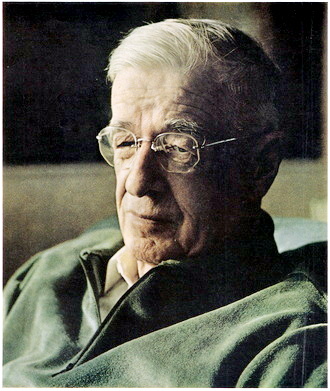
And the young man. As always he will build his own concepts, and his own loyalties. He will follow science where it leads, but will not attempt to follow where it cannot lead.
And, with a pause, he will admit a faith.
Dr. Bush, now honorary board chairman of Massachusetts Institute of Technology, was dean of its school of engineering when, in the 1930’s, he developed the Bush Differential Analyzer—grandfather of modern-day computers. He left M.I.T. in 1938 for the presidency of the Carnegie Institution of Washington; after the fall of France in 1940, President Roosevelt named him chairman of the National Defense Research Committee. Five months before Pearl Harbor, in 1941, Dr. Bush’s job became director of the Office of Scientific Research and Development, which Dr. Bush headed throughout the war and until its mission was accomplished, in 1947.
